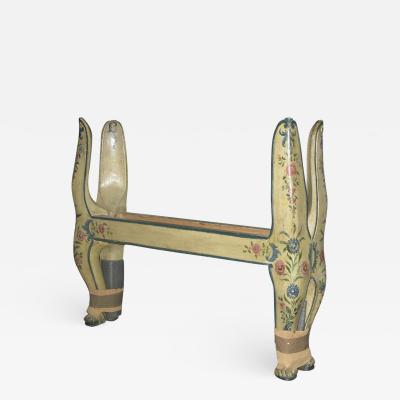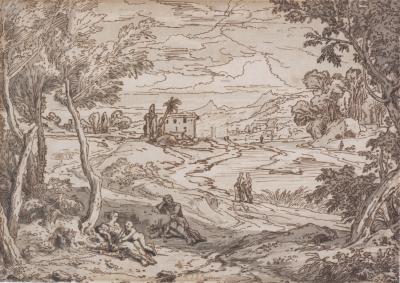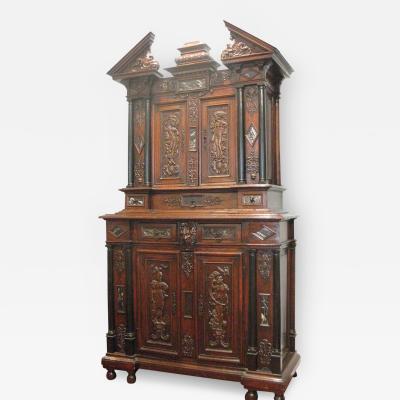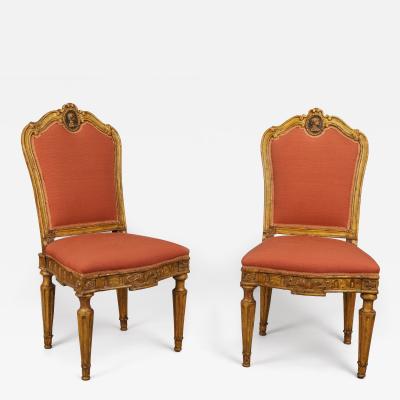Listings / Fine Art / Works on Paper / Other
Ceremonial Gondola of the French Ambassador in Venice
-
Description
Inscribed on the mat- Gondola dell' Ambasciatore Franceses in Venezia 1682/Dalle collezione dei Disegni del cav. Humin
The French artist, Louis Dorigny was the son of a professional engraver who transferred his father-in-law’s, Simon Vouet’s work to engraving. Dorigny was named painter to the French king, Louis XIV having already won the second prize at the Academié the year before. His first works were noted in 1673 when Louis Dorigny was 19 years old, but the records for his drawings and engravings do not go beyond the end of the seventeenth century when Louis began devoting himself to fresco cycles in Italy. The very young Louis Dorigny’s drawings or paintings were not signed, which caused them to be confused with his father Michael, and his brother Nicolas’ works, but Louis was considered the most interesting of the three artists.
When he left for the classic travels of Italy, he remained in Rome to draw antiquity and study the works of the old masters and the contemporary Roman artists. Nikodemus Tessin, during a visit to Rome in 1673 described Louis Dorigny as painting at the church of St. Agnes in Piazza Navona. There now only remains an engraving Dorigny made of Raphael’s Battle of Ostia from this time. Dorigny’s style was called “elegant and sublime.” Mariette, the collector, talked of Dorigny’s “esprit,” his vivacity and movement, which retained a freshness and immediacy and noted a more mature expression in his works and personality.
He arrived in Venice in 1678, and worked there until the beginning of the eighteenth century. Dézaillier D’Argenville was the first to discuss him in his book, Abrege de’ la vie das plus fameaux pientres and discusses his biography in volume IV, pages 271-280. Louis Dorigny printed a volume in Venice with 32 small views not more than 10 cm. high and 5-6 cm. wide. Dominique Bouhours (1628-1702) printed his illustrations for Penseé Chretiennes Pour tous les jours du mois in 1684 in Venice, which continued being printed until the mid-nineteenth century. The volume was dedicated to G.P. Giovanelli who had been recently ennobled, but others, such as the Manin, Zenobia, Montemar, and Widman, all appreciated his work and commissioned Dorigny to paint in their palaces.
The very close relationship between Dorigny and the French colony in Venice are made obvious by the French texts for the other drawings for engravings made in the same period. The French presence was made much of in Venice. For the occasion of the triumphal arrival of Louis XIV’s ambassador’s in 1682 – Michel Amelot De Gournay the arrival of the first gondola, followed by four others in his suite was of particular significance and importance following the policies of Louis XIV for pomp and grandeur.
Dorigny drew for Trudon the start of the embarkation of the cortege on the Grand Canal. It is most probable that the project for the decoration of the gondola, with its allegorical representations were also designed by Dorigny. Dorigny was in contact with the official French miliéau. The Venetians thought anything French was most fashionable. Dorigny was almost certainly the supplier for the drawing for the engraving by Jérôme Trudon, destined to be shown in France. (Trudon is described by G. K. Nagel in his Neues Allgemenes Künsler Lexicon Munich 1836 xix page 138 as active in Paris between 1680-1690).
Dorigny worked for the Portin family in Venice with an Allegoria della pittura before moving to Verona in 1687, but from where he continued to supply works for editors, also in Padua. The small drawings were described by D’Argenville as being “hatched from right to left, but rarely crossed.” He described, “seeing spirit, fire, abundant intelligence and expression which distinguishes these drawings from other masters. While he excelled at large subjects he was most attached to conferring perfection on small sheets,” as can be seen on this remarkable rare surviving sheet which is inscribed by the same hand with the subject and date on the verso. -
More Information
Notes: We wish to thank Proffessore Giorgio Fossaluzzi for the attribution. Origin: France Period: 18th Century Materials: Sepia on waxed paper Condition: Fair. Creation Date: 1682 Styles / Movements: Old Master, Other Incollect Reference #: 305550 -
Dimensions
W. 2.13 in; H. 6.13 in; W. 5.41 cm; H. 15.57 cm;
Message from Seller:
The gallery deals in European works of art, antiques and paintings from antiquity to the end of the eighteenth century. Under Mrs. Fioratti's direction, the gallery has continued to supply works of art to museums across America and Europe. She has designed interiors in the U.S., Europe, and the Middle East. Mrs. Fioratti has worked on architectural restorations, and restored a 10th century village near Siena.
Sold































